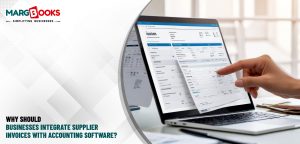When it comes to managing finances, whether for a small business or a large corporation, one thing is clear: financial clarity is key. Without it, you run the risk of confusion, mismanagement, and potential losses. To avoid these pitfalls, understanding and applying the 3 golden rules of accounting is crucial.
Accounting isn’t just about numbers; it’s about clarity, control, and insight into your financial health. In this blog post, we will explore these three golden rules of accounting, along with how tools like accounting software and billing software can help you stay on top of your financial game. Let’s dive in!
What are the 3 Golden Rules of Accounting?
Accounting may seem complex to some, but the truth is that it all boils down to a few fundamental principles. These principles, known as the 3 golden rules of accounting, form the backbone of accounting practices. Understanding these rules is the first step to achieving financial clarity and success.
1. Debit the Receiver, Credit the Giver
This rule is the basis of every financial transaction. It states that when something is received, it must be debited, and when something is given, it must be credited.
- Debit the Receiver: If your company receives cash or goods, you need to debit the account receiving the value. For example, if you receive payment from a customer, you would debit your cash or bank account.
- Credit the Giver: Conversely, when you give goods or services or make a payment, you credit the account that is providing the value. For instance, when you pay a vendor for supplies, you credit the accounts payable or vendor account.
This rule ensures that every transaction is accurately recorded, maintaining balance in your books.
2. Debit What Comes In, Credit What Goes Out
This rule applies to assets, liabilities, and equity. It focuses on the movement of resources and the flow of value.
- Debit What Comes In: When you acquire new assets or resources (like inventory or equipment), you debit the account that is receiving the benefit. For example, buying new equipment or receiving a payment from customers would require you to debit your assets.
- Credit What Goes Out: Similarly, when you dispose of assets or incur liabilities, you need to credit the corresponding accounts. Selling equipment or making a payment for outstanding bills would require a credit to the appropriate account.
This golden rule maintains the balance between what the business owns and owes.
3. What is the Benefit to One is the Expense to the Other
This rule emphasizes the dual nature of every transaction. Every financial activity impacts both the giving and receiving parties. While one party may benefit from a transaction, the other must incur an expense.
For example:
- Revenue and Expenses: When a business earns income, it benefits (and the customer incurs the cost). In contrast, when a business spends on its operations, it incurs an expense (and the supplier benefits).
- Income and Liabilities: In situations where you receive a loan, the business benefits (the cash or asset comes in) while the liability (the loan amount) is credited.
The third rule is important because it reminds you that each transaction has two sides—what you gain and what you lose.
How Do the 3 Golden Rules of Accounting Promote Financial Clarity?
The 3 golden rules of accounting are the foundation of proper financial record-keeping. By applying them correctly, you ensure that your financial statements are accurate and transparent. This transparency leads to:
- Clear Financial Overview: The application of these rules results in balanced accounts, making it easier to analyze your business’s financial status at any given time.
- Informed Decision-Making: Financial clarity helps business owners make decisions based on accurate data. Whether it’s about investments, cost-cutting, or expansion, you need a clear view of your books.
- Simplified Audits: Properly following the golden rule ensures your books are prepared for audits without any hitches. Auditors can easily trace your transactions, making the auditing process smoother.
Tools to Simplify Accounting: Accounting Software and Billing Software
While the golden rules provide a clear structure for your accounting practices, the tools you use to manage your financial data play an equally important role in maintaining financial clarity. Here’s where accounting software and billing software come in.
1. Accounting Software: A Digital Solution for Better Management
Accounting software is a powerful tool that automates many of the manual processes involved in accounting. From tracking income and expenses to generating financial statements, accounting software ensures that your books are always up to date and accurate.
Benefits of Accounting Software:
- Real-Time Data: Stay on top of your finances with real-time tracking of transactions and balances.
- Ease of Use: Modern accounting software is user-friendly and does not require extensive training.
- Reports and Analytics: Get instant access to financial reports and insights, helping you make informed decisions.
- Integration: Many accounting software programs integrate seamlessly with your existing business systems, like billing software.
Margbooks is an excellent example of accounting software that simplifies your accounting processes. With Margbooks, small business owners can easily manage GST filings, track their expenses, and generate financial reports effortlessly. Whether you’re managing a small retail store or a larger enterprise, Margbooks ensures you follow the right accounting practices.
2. Billing Software: Streamlining Payments and Invoices
Billing software is another indispensable tool that works in tandem with accounting software. It simplifies the invoicing process, helping businesses manage client payments efficiently.
Benefits of Billing Software:
- Invoice Generation: Automatically generate professional invoices with accurate details and taxes.
- Payment Tracking: Keep track of payments made and outstanding dues.
- GST Compliance: Many billing software programs, including Margbooks, are GST-compliant, making it easier to stay compliant with Indian tax laws.
Billing software ensures that your invoicing is accurate, timely, and in line with the accounting practices outlined in the golden rules.
Conclusion
Achieving financial clarity is essential for the smooth functioning of any business. By understanding and applying the 3 golden rules of accounting, you create a solid foundation for your financial management. To complement this, using powerful accounting software and billing software, such as Margbooks, can further streamline your accounting practices and ensure that you remain on top of your financial game.
Remember, financial clarity isn’t just about balancing books—it’s about gaining insights that allow you to make smart, informed decisions for your business’s growth. Apply these rules, embrace the right tools, and watch your business thrive with confidence.




